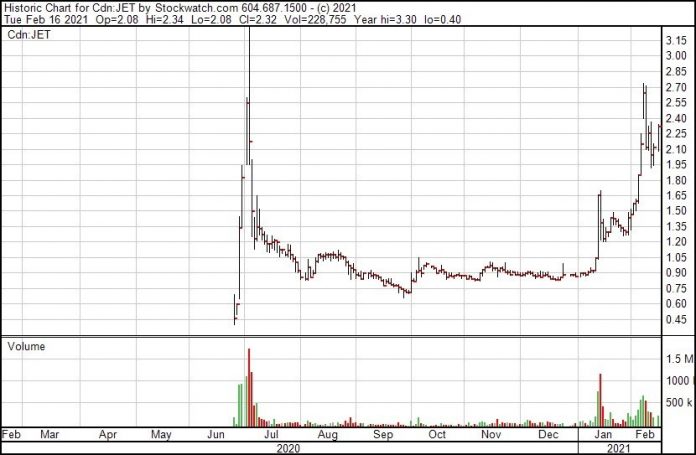Never waste a good crisis. And for the airlines, COVID has been a crisis.
But for Miami-based GlobalX (JET-TSXv)—a new airline hoping to launch within weeks—it has been a blue sky opportunity.
You see, now the small airlines are able to get veteran, high quality pilots, IT personnel, stewards and other staff that pre-COVID would have been near impossible. And with global industry hurting, renting planes is less than half the cost of what it was pre-COVID.
In fact, CEO Ed Wegel and CFO Ryan Goepel are set to take off—pending final FAA certification—on raising just $7 million.
So they are quite excited. And by the look of their stock chart, so are their investors.

Here’s what I call The Quick Facts:
QUICK FACTS
Trading Symbols: JET-TSX/JETMF-USA
Share Price Today: C$2.15
Shares Outstanding: 35.7 Million (44.9 Million FD)
Basic Market Capitalization: C$76.8 Million
Net Debt: (C$0) Million
Enterprise Value: $76.8 Million
The next big catalyst for GlobalX is their FAA (Federal Aviation Administration) certification in the USA—the final step of five that any new airline has to go through.
In a recent interview, Goepel said certification is on track with pilots and FAs in training. GlobalX has scheduled the remaining tasks with the FAA, subject to COVID restrictions.
Global X will operate under ACMI agreements (aircraft, crew, maintenance and insurance)—which is almost just like you as a regular person would rent a car. If you hired a driver with your rent a car, that would be ACMI.
So think of GlobalX as a wholesale charter company. They hustle out to all the big airlines now—in this unique time when the industry is obviously at record low utilization—and secure planes really cheap, and lock those rates in for as long as they can.
And we are not talking ANY planes—we are talking YOUNG planes. These are planes that can fly more hours per month and have a lot lower maintenance costs—than what normal charter airlines could ever get in a busy aviation market.
“When you look at capital outlay, instead of putting out $2,000,000 (i.e. pre-COVID), we’re able to put out $400,000 effectively now, get the exact same asset,” Goepel told me. He estimates their cost is 30-40% lower than any competitor—especially the other airlines that have big debt.
Their plan is to book 10-20 planes ASAP, with as long a contract as they can get at these cheap rates. If they can achieve 150 hours per month per plane at $1,000 operating profit per flight hour, their business becomes very easy for the Street to model. (That helps to get a better multiple of cash flow on valuation)

Not only do they have to hustle their supply, they have to hustle their customers. That would be the regular charter business (think sun-worshippers at peak times like Xmas & Easter, and summer vacation; peak travel times). But it would also be groups like
- pro sports teams and other group travel customers
- Major Hotel/Casino groups
- National airlines for small countries (think South America)
- Cargo
All of a sudden these customer groups can take advantage of higher quality staff on relatively new planes in a company with a much lower cost structure (no legacy assets and no debt).
So what happens is—the above 4 customer groups do the marketing to fill the seats on the plane, and then GlobalX flies them. That guarantees every flight will be profitable for JET-TSXv. If it’s not, the charter gets cancelled. There is no large itinerary of set flights that fly no matter what.
Example–they just announced a deal to fly between Venezuela and Miami for Estelar. Estelar pays GlobalX–in advance–a fee per flight and Estelar takes all the risk on whether that flight is full and profitable or not.
Ed Wegel is Chairman, CEO and Founder of Global X. He’s a seasoned airline executive who started in the industry in the 1980’s – first as an investment banker for Lehman Brothers in NY in 1987—where he worked on airline restructurings and commercial leases.
Subsequently he was a senior executive and/or Board Member for several private and public airlines from 1991 to the present. Ed has seen almost every iteration of the industry, every business model and every up and down.
Global X announced a business combination with Canada Jetlines Ltd. to take the company public on December 13, 2019, well before the North American onset of COVID-19.
Although the deal didn’t close until June 23, 2020, its timing put Global X in a unique position to plan for a recovery.
Wegel, Goepel and the team expect to fly 10 planes in 2022. At 150 hours per month, they believe each plane will generate US$1.8MM EBITDA per year and the 10 plane fleet would generate US$18MM of EBITDA. After ~US$4MM of overhead, profit would be US$14MM which scales up to US$32MM as the monthly hours increase to the long-term goal of 300 hours per month.

Global X plans to operate in the charter and cargo subsectors of the industry. Direct comps are limited so we present historical EV/EBITDA multiples for Canadian airlines (AC-CA, EIF-CA), Couriers & Logistics (UPS-US, FDX-US, DWP-DE) and Air Cargo Transport (AAWW-US, ATSG-US, CJT-CA).
Historic EV/EBITDA multiples range from ~4x to 14x and average ~9x for all of the listed companies.




Using the company’s 10 plane estimates and from above and a range EV/EBITDA multiples from 5x to 10x, simple math gets an EV ranging from C$116MM to C$231MM for the 150 flight hours per month case versus the current basic EV of ~C$70MM. Obviously, utilization and fleet size will increase the EBITDA estimates.

Just as a couple final notes:
- With respect to cargo operations, management believes that its A321 strategy provides an invaluable solution to an impending problem. The current freighter market is dominated by the Boeing 767, 757 and 737 freighters. There are currently 313 757f in service with the two largest operators being FedEx (107 planes with and an average age of 28.7 years) and UPS (75 planes with an average age of 27.1 years). These planes are reaching end of life with limited options for replacement.
Management believes that the market will shift to 737-800 or A321 aircrafts simply due to logistics (cargo capacity and operating economics) and believes that its A321 cargo aircraft will be an extremely attractive option.
- If all goes well this year, Global X also plans to spin out Canada Jetlines Vacations brand into a separate Canadian listed company. Global X shareholders will get a proportionate interest in Canada Jetlines.
This all sounds very rosy doesn’t it? Except they can’t fly yet. But they have certainly got a strong plan, and have done a lot with just $7 million in capital.
DISCLOSURE–I am long GlobalX









